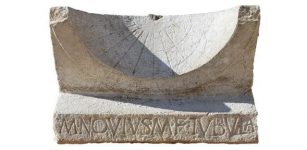Deeper Look Into Chinese Swords Throughout The History Of The Dynasties
Rafael - AncientPages.com - In history, there were a lot of prominent swords used for battle. The Chinese also had a number of swords that became known due to their excellence in the battlefield.
Their swords were classified into two different types namely the Jian and Dao. The Jian swords had double edges and were straight unlike the Dao. These were single-edged and usually had curved blades. The curve was more prominent especially during the Song Dynasty onwards.
The Earliest Chinese Swords
The Jian has been considered as a long sword while the Dao, as a knife or saber. The bronze Jians first came to existence during the mid-3rd century BC. Eventually, during the late Warring States period, the Jians were made using steel and wrought iron.
Folded Steel Chinese Han Sword double edge, sharp on both sides, standard fittings. Credit: Katanas For Sale
The Chinese swords were also used outside of China. These were utilized in Japan during the 3rd to the 6th century AD. However, in the middle of the Heian period of Japan, the Chinese swords were replaced by the Korean and native Japanese swords or nihontos.
The Zhou Dynasty – The Jian Swords
The Jian swords appeared during the Western Zhou Dynasty. As mentioned earlier, these were first made from bronze then later shifted to steel and wrought iron. The Jian’s blade often measured around 28 to 46 centimeters in length. As stabbing blades, the Jian were considered the last resort when all other options have failed.
By the late Spring and Autumn Period or Chunqui Shidai, the length of the Jians increased and measured around 56 centimeters. During this time, a few soldiers wielded the Jian instead of the dagger-like axe because of its increased portability and flexibility. Right after the end of the Qin Dynasty, the sword dance started becoming popular. With that, Jian swords that reached up to 110 centimeters started to appear.
Map of the geographical extension of the Zhou Dynasty 1000 B.C. Credit: nationsonline.org
In the Han Dynasty, the Jian was a popular blade. With that, a certain class of swordsmen appeared and made their living from fencing. Sword fencing was popular among aristocrats. It was so prominent that a 37-chapter manual called the Way of the Jian was created. However, the manual no longer exists in this day and age.
These swords developed by the end of the Three Kingdoms. The lighter and more durable double-edged Jians appeared for dancers, warriors, and even officials. Under the Yuan Dynasty, the weapon was revived and was utilized more often. In the Ming Dynasty, the prominence of the Jian once again declined. However, a few arms specialists saw limited use for the sword.
The Shang Dynasty – The Rise of the Dao
These are single-edged swords and are mainly designed for chopping and slicing. Its most common form is also called the Chinese saber, though the wider bladed pieces are often called the Chinese broadswords.
The Dao is also part of The Gentleman of Weapons and the earliest piece dates back to the Chinese Bronze Age during the Shang Dynasty. These were known as the Zhibeidao – they were straight-backed knives. Just as the name states, these Dao either had slightly arched or straight blades with a single edge. During the Han Dynasty, Dao with ring pommels also become popular for cavalry use although the Jian was still in large use by the military.
Chinese Shang dynasty bronze face masks, 16th–14th century BC. Credit: Public Domain - CC BY-SA 4.0
This weapon had the advantage of being single-edged. It’s because its dull side could be thickened to add to the sword’s strength, decreasing its chances of breaking. With a shield, the Dao made for a great replacement for the Jian sword. With that, it became a preferred option as time passed. After the Han Dynasty, individuals practicing sword dances utilized the Dao over the Jian. During the Three Kingdoms, the Dao completely took over the Jian as the warrior’s choice of combat weapons.
During the Tang Dynasty, the Dao was also segregated into four categories. These were the Defense Dao, Divided Dao, Cross Dao, and the Ceremonial Dao. In the Ming Dynasty, the sword took on the role of the preferred close-combat weapon of that time.
Famous Chinese Swords Throughout History
Aside from the basic Jian and Dao, there were other Chinese swords utilized throughout time. If you’re curious about these, then read along and learn about these historical Chinese swords.
The Iron Sword of the Qin Dynasty
The Iron Sword is a kind of Dao that is entirely made of iron. This piece was usually thrown at enemy soldiers from a safe spot to prevent the wielder from getting attacked. These were first produced in the Qin Dynasty.
The Ming Dynasty’s Changdao
This sword was a certain type of anti-cavalry blade utilized for battle. It was sometimes called the Miao Dao - a similar but more recent blade - that appears similar to that of the Japanese Nodachi.
The Niuweidao of the Late Qing Dynasty
This was a kind of Chinese Dao that appeared during the late Qing Dynasty. It was mainly used as a civilian’s weapon. the imperial Chinese troops were never issued with this specific sword.
The Piandao and Wodao
The Piandao of the late Ming Dynasty was another type of Chinese Dao with a deeply-curved blade. This meant that the sword was designed for draw cutting and slashing. It appeared just like the scimitar and the shamshir. The Piandao was quite uncommon and was often utilized during skirmishes together with a shield.
The Wodao of the Ming Dynasty was highly influenced by the design of Japanese nihontos. It has a strong resemblance to the nodachi or tachi in form. Surviving pieces display handles that measure around 25.5 centimeters long accompanied by a slightly arched blade that is 80 centimeters in length.
The Liuyedao of the Ming and Qing Dynasties
The Liuyedao translates to willow leaf saber and is a kind of Dao that was often used by warriors. It was a military sidearm for the infantry and cavalry units during war.
Yanmaodao of the Late Qing to Ming Dynasties
This translates to goose quill saber and is one of the types of Dao’s produced in large numbers. This is due to it being the basic military weapon of soldiers during the Ming Dynasty throughout the end of the Qing Dynasty.
The Song Dynasty’s Zhanmaodao
This piece was a long, single, and broad-bladed sword that features a long handle that was perfect for double-handed wielding. It dates all the way back to the year 1072 and was utilized as an anti-cavalry piece.
Other Popular Chinese Swords In History
There were other different swords utilized throughout the history of China and some are also being used until today. The Nandao is one of the pieces that are used today for most modern wushu forms and exercises. It’s the southern variation of the Beidao or Northern Broadsword.
The Dadao is among the varieties of the dao and is more commonly known as the Chinese Great Sword. It was based on agricultural pieces so the Dadao features broad blades that are around two to three feet in length. It had long hilts for double-handed use or half and a half; plus, its balance was usually weight-forward.
For the Miaodao, it is specifically a double-handed dao of the Republican Period. It features a narrow blade that was about 1.2 meters long and was accompanied by a long hilt. Together with the Dadao, this blade was sometimes utilized by Chinese soldiers during the 2nd Sino-Japanese War.
There was also a piece called the Butterfly Sword. It is a short dao that was originally produced in Southern China. These are commonly utilized in a couple of Chinese martial arts like Hung Ga, Wing Chun, and Choy Li Fut.
Lastly, there was also a piece called the Hook Sword. It is one of the most exotic-looking Chinese blades that was associated with the Northern style of martial arts. Yet today, the sword is also utilized for the Southern style of martial arts as well.
Written by – Rafael - AncientPages.com Contributor
Copyright © AncientPages.com All rights reserved. This material may not be published, broadcast, rewritten or redistributed in whole or part without the express written permission of AncientPages.com
More From Ancient Pages
-
 Ancient City Of Timgad: Largest Roman Settlement Ever Built In North Africa
Civilizations | Feb 28, 2023
Ancient City Of Timgad: Largest Roman Settlement Ever Built In North Africa
Civilizations | Feb 28, 2023 -
 Understanding The Green Sahara’s Collapse
Earth Changes | Aug 22, 2024
Understanding The Green Sahara’s Collapse
Earth Changes | Aug 22, 2024 -
 Large Palace Discovered At Mayan City Of Kulubá In Yucatan, Mexico
Archaeology | Dec 27, 2019
Large Palace Discovered At Mayan City Of Kulubá In Yucatan, Mexico
Archaeology | Dec 27, 2019 -
 This Is The Mysterious Hilltop Where Civilization Began Scientists Say
Archaeology | Jun 24, 2022
This Is The Mysterious Hilltop Where Civilization Began Scientists Say
Archaeology | Jun 24, 2022 -
 Strange Case Of The Italian Doppelganger – A Tragedy – Part 1
Featured Stories | Oct 14, 2019
Strange Case Of The Italian Doppelganger – A Tragedy – Part 1
Featured Stories | Oct 14, 2019 -
 Poles conduct mural restoration in the villa buried by the ashes of Vesuvius
News | Aug 26, 2015
Poles conduct mural restoration in the villa buried by the ashes of Vesuvius
News | Aug 26, 2015 -
 Secret Hidden Freemasonic Messages Concealed In Ancient Egyptian Artifacts And Roman Works – A Misunderstood Object? – Part 1
Ancient Mysteries | Feb 18, 2022
Secret Hidden Freemasonic Messages Concealed In Ancient Egyptian Artifacts And Roman Works – A Misunderstood Object? – Part 1
Ancient Mysteries | Feb 18, 2022 -
 What Rights Did Viking Women Have?
Ancient History Facts | Mar 19, 2021
What Rights Did Viking Women Have?
Ancient History Facts | Mar 19, 2021 -
 Dian Cécht – Celtic Healer Who Cured Many But Killed His Own Son Of Professional Envy
Celtic Mythology | Sep 19, 2020
Dian Cécht – Celtic Healer Who Cured Many But Killed His Own Son Of Professional Envy
Celtic Mythology | Sep 19, 2020 -
 Lost Treasure Of King Atterdag Remains An Unsolved Ancient Mystery
Featured Stories | Jul 13, 2017
Lost Treasure Of King Atterdag Remains An Unsolved Ancient Mystery
Featured Stories | Jul 13, 2017 -
 Freemasons Secrets – American Democracy Is Part Of An Ancient Universal Plan – The Beginning And The Dream Of A Brotherhood Of Men – Part 1
Ancient Mysteries | Jul 12, 2018
Freemasons Secrets – American Democracy Is Part Of An Ancient Universal Plan – The Beginning And The Dream Of A Brotherhood Of Men – Part 1
Ancient Mysteries | Jul 12, 2018 -
 Did Ancient Oshoro Stone Circle Serve As A Portal To The Spirit World?
Featured Stories | Aug 19, 2017
Did Ancient Oshoro Stone Circle Serve As A Portal To The Spirit World?
Featured Stories | Aug 19, 2017 -
 Discovery Of Half-Million-Year-Old Wooden Structure Shows We’re Wrong To Underestimate Our Ancient Relatives
Featured Stories | Oct 10, 2023
Discovery Of Half-Million-Year-Old Wooden Structure Shows We’re Wrong To Underestimate Our Ancient Relatives
Featured Stories | Oct 10, 2023 -
 Oldest Canoe Ever Discovered In Maine – It Dates To 1280-1380 A.D
Archaeology | Jun 13, 2019
Oldest Canoe Ever Discovered In Maine – It Dates To 1280-1380 A.D
Archaeology | Jun 13, 2019 -
 New Species Of Stegosaur Is Oldest Discovered In Asia, And Possibly The World
Fossils | Mar 7, 2022
New Species Of Stegosaur Is Oldest Discovered In Asia, And Possibly The World
Fossils | Mar 7, 2022 -
 4,500-Year-Old Sumerian Palace Discovered In The Ancient City Of Girsu
Archaeology | Feb 20, 2023
4,500-Year-Old Sumerian Palace Discovered In The Ancient City Of Girsu
Archaeology | Feb 20, 2023 -
 On This Day In History: Ceres Discovered By Giuseppe Piazzi – On Jan 1, 1801
News | Jan 1, 2017
On This Day In History: Ceres Discovered By Giuseppe Piazzi – On Jan 1, 1801
News | Jan 1, 2017 -
 Rare 2,000-Year-Old Intact Sundial With Inscription Discovered In Italy
Archaeology | Nov 9, 2017
Rare 2,000-Year-Old Intact Sundial With Inscription Discovered In Italy
Archaeology | Nov 9, 2017 -
 Easter Island’s Statues Reveal Bodies Covered With Unknown Ancient Petroglyphs
Archaeology | Jan 21, 2014
Easter Island’s Statues Reveal Bodies Covered With Unknown Ancient Petroglyphs
Archaeology | Jan 21, 2014 -
 Mysterious Underground City In Brazil Could Re-Write Ancient History – Riddle Of The 12 Men – Part 2
Ancient Mysteries | Jan 26, 2022
Mysterious Underground City In Brazil Could Re-Write Ancient History – Riddle Of The 12 Men – Part 2
Ancient Mysteries | Jan 26, 2022




